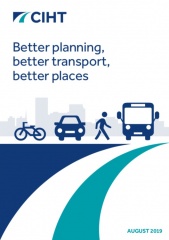Better planning, better transport, better places
Document types:
Document weight:
Document geography:
Geographical spread:
For the last 20 years, governments have attempted to encourage a more sustainable approach to transport within spatial planning but have made limited progress.
Car parking and traffic still dominate housingdevelopments. Sustainable access to local services is poor. Sustainable approaches to transport are largely non-existent. The way we currently travel and thecontinued growth in road traffic are damaging our health,harming our towns, and contributing to climate change.
Our quality of life depends on transport and easy access to jobs, shopping, leisure facilities, and services. Weneed an efficient and integrated planning and transportsystem to not only support a strong and prosperous economy but to reduce carbon emissions. As a sector, we are not achieving these goals.
The current planning practice is not delivering the best outcomes. New developments frequently fail to achieve sustainability because of their locations, the approaches taken to provide access, or the attitudes of everyone involved in their planning and delivery. Far too many examples still exist where the long since discredited approach of ‘predict and provide’ is used to the detriment of planning better places.
The government, professionals, and communities recognise the need for change. The revised National Planning Policy Framework of February 2019 (NPPF) has moved national policy in the right direction, butpractice must also change significantly in a number ofways if we want future developments to provide healthy, successful places for people to live in.
Integrating sustainable transport into new developments is key to achieving that outcome, but three key barriers stand in the way:
- Local authorities are not setting out a vision for development in their Local Plans that includes setting accessibility and mode share targets to which developers and promoters can respond.
- Limited practical examples demonstrate how to deliver sustainable transport outcomes which reinforce risk-averse approaches.
- Collaboration between planning and transportregulatory and delivery bodies is either insufficient or ineffective.
This advice document focuses on the critical practical steps that can be taken by planning professionals, developers, advisers, and local councils to overcome these barriers, from developing a strategic or Local Plan to delivering a development. It not only works within the context of current planning legislation and the NPPF but also provides recommendations for the government for improving current policy.
Through this advice, creating places that meet the requirements of the 21st century in terms of all the critical elements of environmental, economic, and social sustainability, and responding to climate change,while also effectively delivering the homes needed will be possible. The effective integration of planning andtransport is fundamental to achieving this objective.

